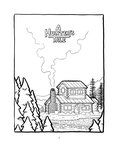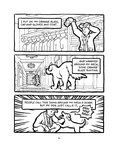





As comic artist Ryan Claytor sat down to begin work on his latest graphic novel, “A Hunter’s Tale,” he revisited the poetry of his late grandfather. The poems lifted Claytor off into a nostalgic trance and in his mind’s eye he sees his grandfather. He’s trudging through woodlands — rifle in tow; his loyal dog by his side. The calm November air is as crisp as the freshly fallen leaves on the ground and the wind’s bittersweet bite heightens his senses.
“A Hunter’s Tale” is a story driven by a powerful connection between a grandson and his grandfather, the respect mother nature commands of us all and the eternal conflict and reluctant bond of the hunter and the hunted.
“I feel like I’ve been able to see this poem for a long time. This is a very visual, narrative-driven poem about two seemingly disparate subjects: a hunter and his prey. Over the course of the poem, they form an unlikely understanding of one another,” Claytor said.
Claytor, 42, is an adept illustrator and an expert in the vast world of comic books. He coordinates Michigan State University’s comic art and graphic novel minor and is the college’s first ever professor to teach comic studio courses. In 2009, Claytor’s work was exhibited by the Cartoon Art Museum in San Francisco. In 2019, he co-authored “Coin-Op Carnival,” a four-volume comic series that takes readers on a deep dive into the world of pinball.
“Comics are made of words and images, and together they can create literally anything. There is no budget — you have a pencil and paper, and you can make whatever you want,” Claytor said.
Claytor began work on “A Hunter’s Tale” — serialized in City Pulse for four weeks, beginning today — last year, with the full book scheduled for release this month. While the illustrations are wholly original, the narration and dialogue are taken directly from an old poem written by his late grandfather, Charles Kermit Claytor.
“It’s been with me for as long as I can remember,” Claytor said of the poem. “It was written in 1983, and it’s been a part of my life for a long time. He wrote a number of poems, but whenever I got to this one, I stopped dead in my tacks. It’s my absolute favorite.”
The elder Claytor was born in the Midwest, growing up in the small town of Alma, Illinois. But he didn’t learn to hunt until he moved to the outlands of Arizona. He developed a wickedly accurate shot with his rifle, as each piece of game he came across had to be taken out with just one hit. For if he fired more than a single round at a time, the game warden would be able to quickly locate and charge Charles Claytor, who was living off the land illegally.
“My grandfather lived an interesting life. He was born in the early 1900s and was diagnosed with tuberculosis and a young age,” Claytor said. “From my understanding, at that time, tuberculosis was essentially a death sentence. He was told to go out to the deserts of Arizona in hope that the dry desert air would cure him of the disease. That’s what he did, he moved to Arizona and lived off the land. Because I’m here, you can surmise he made it through.”
Claytor is not a hunter. He details that he lacks the fortitude to even place a worm on a hook. But contemplating his grandfather’s predicament — far from home and penniless, resorting to killing and catching game in order to feed himself — forced Claytor to think emphatically. Claytor ultimately reached the conclusion that if his hand was forced, he would follow the same path as his grandfather. This approach to reaching an understanding with something unfamiliar is one of the major themes Claytor hopes to get across in “A Hunter’s Tale.”
“I think if I were in that situation, I would have done the same thing. This poem has taught me empathy on a number of different levels as well. I am so excited to share that with more people,” Claytor said.
After his time as a wild man in Arizona, Charles Claytor eventually moved to Colorado, where he lived in a riverside log cabin. In his childhood, Claytor would visit his grandfather during the summer. He has vivid memories of walking alongside the river that appears on the first page of “A Hunter’s Tale.” Charles Claytor died in 1999 at age 93.
“Looking back, I think it’s really to inspiring to know what he went through and how well he came out after all that,” Claytor said.
The genesis of “A Hunter’s Tale” was further driven by the convergence of major watershed moments in American society that took place in the past two tumultuous years — including the failed insurrection at the Capitol Building and the murder of George Floyd. Claytor cites his growing sense of visceral division across the United States as further inspiration to pen a graphic novel that explores themes of empathetic understanding and coming together in spite of differences.
“We’ve all been through the past two years together; I don’t have to explain it all. With each passing day, it seems like we become more separated from one another,” Claytor said. “In this day and age, it’s so easy to click ‘defriend’ and cut people out of your life and surround yourself with people who think very similarly to you. I feel that is dangerous. We should be open to listening and trying to understand people who are different from us.”
For the next installment of “A Hunter’s Tale,” pick up the Jan. 12 issue of City Pulse.Support City Pulse - Donate Today!
Comments
No comments on this item Please log in to comment by clicking here